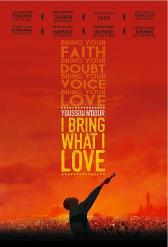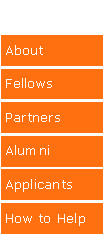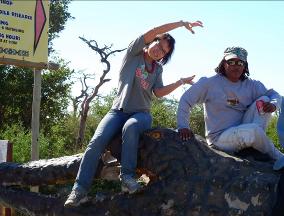
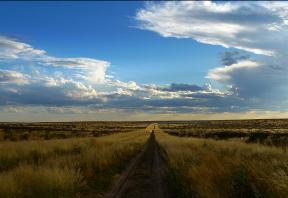
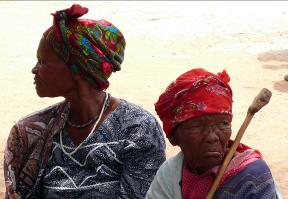
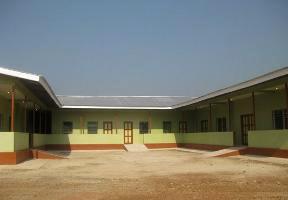
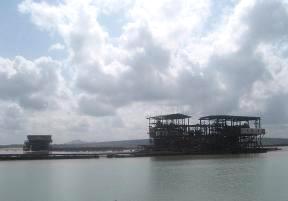
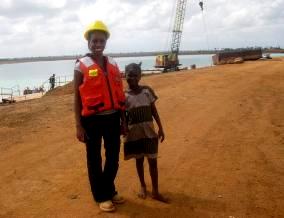
|
Upcoming Events
New Fellows’ Reception June 1, 2:00-4:00 PM, 194 Nassau Street, Suite 219 A special Class Day reception for 2009-2010 Fellows and their families. Please join us as we send off our newest class of Fellows! |

|
Fellows’ Flyer |
|
June 2009 |
|
News and views for and by Princeton in Africa Fellows |
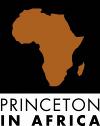

|
In this Issue: |
|
Highlights from 2008-2009 Fellows Jasmine Clerisme in Sierra Leone, Jenn Ruskey in Botswana, and Emily Stehr in DR Congo |
|
Happy Birthday |
|
June 11 Jing Ren
June 29 Stuart Malcolm
June 30 Emily Stehr |

|
New Fellows Selected
We are thrilled to announce that 24 new Princeton in Africa Fellows have been selected for our 2009-2010 fellowship year. They will work with 13 different organizations in 16 countries. For more information about our new Fellows and where they have been placed, click here. |
|
The Technical Institute |

|
I’m not sure that many Americans know what rutile is—I certainly didn’t before taking up my fellowship post that was made possible because of this glittering black sand. Though Sierra Leone is most well known for the diamonds that played a central role in the brutal civil war that took place here from 1991-2002, the country is rich in other mineral resources, rutile being one of them. Sierra Rutile Limited (SRL) has been mining rutile, a titanium ore used as a paint pigment, in the southwestern region of Sierra Leone since the 1970s and has been an important contributor to the nation’s economy. At the height of its operations, SRL has been the largest private sector employer in Sierra Leone, as well as the largest source of tax revenue for the government.
A rebel invasion during the war forced Sierra Rutile to close down in 1995. After SRL resumed operations in 2006, local community members expressed their desire to have more local youth employed by the company. SRL recognized that in order for these youth to be qualified for employment, they would have to receive the necessary training, and so the idea to establish a technical skills training institute was born. When a former investor in SRL (who also happens to be a Princeton alum) heard of the plan to establish the school, he donated funds to get the project started. The donor enlisted the help of Africare, an international NGO that has been working in Sierra Leone since 1984, to partner with SRL to implement the school project.
Over the past eight months, I have been working for Africare, overseeing every aspect of getting the technical institute up and running. My responsibilities have entailed making sure that construction is kept on schedule, developing an operating budget for the institute, writing proposals to solicit funds from new donors, securing in-kind donations from Sierra Rutile, and meeting with officials at the Ministry of Education, Youth, and Sports to get the institute legally established. The work I do is unique and challenging in that I’ve had to learn to navigate my way through the different worlds of the public, private, and nonprofit sectors.
The timeliness of establishing this technical institute cannot be overstated. Poor and marginalized youth were easy targets for recruitment by rebel forces during the war. Acknowledging the importance of providing youth with alternatives to engaging in destructive behavior, the government of Sierra Leone has singled out youth unemployment as one of the primary challenges that needs to be addressed in order to ensure continued peace and stability in the country. The training that the students will receive at the institute in subjects like automobile mechanics, building and construction, electrical engineering, and mechanical engineering will prepare them to seek employment at SRL and other companies throughout Sierra Leone, or to open their own businesses.
The enthusiasm and overwhelming support of the Rutile mining community for this institute has been a great source of motivation for me when doing work that can be slow and oftentimes frustrating. Every baby step made toward progress (small small, as they would say in Krio) can feel like a small victory. And yet, the overwhelming feeling that there is so much left to do lets me know that my work on the continent has only just begun. |
|
by Jasmine Clerisme, ‘08-’09 Fellow at Africare in Sierra Leone |
|
Notes from the Field |
|
Jasmine visits the dredge at Sierra Rutile |
|
The dredge and wet plant at Sierra Rutile that mines and processes rutile on a man-made lake |
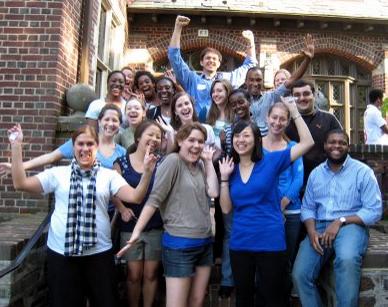



|
Voices of Africa, Princeton’s premiere
|
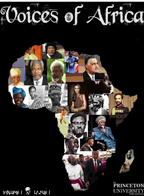
|
Other News |
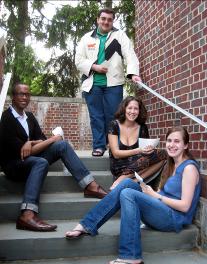
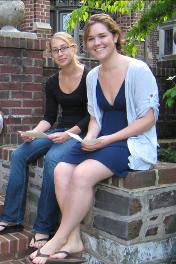
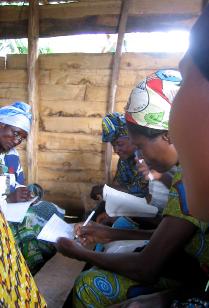
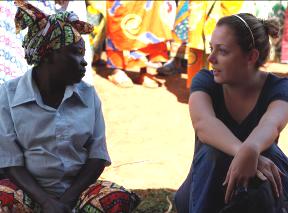

|
Emily talks to a woman in Kalushambu village in South Kivu while an election (for members of a local committee to oversee the building of a community project) takes place. Part of IRC’s Tuungane project, a community-driven reconstruction endeavor, committee members must be democratically elected by their peers, taught to transparently manage the grants IRC awards them to build the project of their choice, and more. Tuungane teaches good governance and helps provide a tangible, necessary thing like a road or well (or something else chosen by the community’s committee). |
|
by Emily Stehr, ‘08-’09 Fellow at International Rescue Committee in DR Congo |
|
Notes from the Field |
|
The members of women’s groups practice writing. Literacy initiatives are a central component of many of these groups’ activities. |
|
In a community center in Miti, South Kivu, about a dozen members of two local women’s groups had helped me pull several benches into a tight circle where they were now perched, eagerly listening to me explain why I had come to visit. The roof over our heads had been almost completely destroyed in the rainstorm last week and a beam of light piercing through one of the holes was blinding me as I used my friendliest, most conditional (the “polite tense”)-laden French to describe my job with the International Rescue Committee (IRC) and what I wanted to discuss with them.
We were in a region of the DR Congo that has been devastated by violent conflict for years. Since the beginning of the war, men in armed groups have used rape as a weapon of war to terrorize and control women and communities. It is a calculated and brutal attack on the society; the perpetrators know that the survivors of sexual violence are generally rejected by their husbands and forced to leave their villages. They are then no longer provided for by their closest companions and they can no longer contribute to the daily functioning of the community. Everything breaks down. But these women’s groups, which are comprised both of survivors and non-survivors from the area, go a long way towards combating these ruthless attacks on stability and peace. I was sitting with these groups on this particular day because my project at the time involved collecting their stories and photographing them for a partner profile we were writing for one of our Gender-Based Violence (GBV) program donors.
Since 2001, several years before the IRC began its GBV program that works with these groups, both women’s groups have served as support networks for survivors. Members bring survivors into their group activities, which include communal gardening, embroidery, dancing and “playing”, as some of the women explained to me. Members also provide emergency response services by seeking out badly injured and abandoned survivors and carrying them to health centers on their backs. Now that the IRC has begun to work with them, the women receive financial support for their group activities and emergency relief services as well as training on advocacy and psychosocial counseling techniques. Thanks in part to these new skills, these ladies have become reputable and serious advocates in their territory’s “Assemblée Générale”, which is comprised of 60 – 70 leaders, all male, representing eight localities in the territory. Recently, their work at an assembly meeting helped put a child rapist behind bars at the province’s Central Prison.
These women are smart and fearless. I wanted to know everything about the way they think. I struggled to find the right questions.
“What do you hope for in the future? I mean, what kind of changes do you hope to see in your group or in your community… what changes do you think will help you accomplish your goals and bring your community closer to functioning how you want it to?”
There was nodding followed by a lot of talking. I let them talk for many minutes.
“We want the IRC to start an animal husbandry program with us. We want you to give us pigs and other animals to raise and sell and trade like you’ve done with other women’s groups. You see, we can breed the animals and we can eat them, and survivors can earn…”
“Right. I know. I know the program,” I said, cutting them off. I could feel myself getting upset. I had been worried for a while that post-conflict development programs were paternalistic in that they created a kind of dependency on outside expertise and resources that squelched local innovation and self-reliance or autonomy. Over the past few months, some of my visits to our program implementation sites made me think it looked an awful lot like “we” were inserting ourselves into “their” communities, changing the ways they did things, and trying to make those changes stick… trying to enforce “our” systems where they otherwise wouldn’t have existed. I had been distressed for some time that I was watching colonialism by another name—post-conflict development, humanitarian aid, or other buzz words—take place all around me. This response I just heard, from *these* women, these amazing women, was making me nervous.
“Ok, no problem,” I thought to myself. “They just didn’t understand. It was just another ‘lost in translation’ moment.” I had had many of them over the past several months. I decided I needed to give an example. That usually worked.
“Ok, so maybe, for example, you were standing in front of the General Assembly one time and the members weren’t taking some of your complaints seriously and you thought, ‘Ugh! I wish there was a female assembly member!’ Or maybe you wish there were a special police force dedicated to protecting women’s rights? Something like that. What kind of change like that do you want to see?”
Lots of talking. Talking and talking for maybe another ten minutes.
“What would make our lives better would be if the IRC would give us livestock. That way we could raise pigs and…”
To do good, you have to do bad. I became sure of that fact that day. And when I accepted it, I got a little more comfortable with it, because I think it really is “good” that’s being done. These women’s lives are more comfortable, by their own accounts, because of what the IRC has added to their efforts. And they are, themselves, making changes to their government and community systems as a result of information they’ve received from the IRC program.
I had developed a theory centered around information-sharing on my six and a half hour-long boat ride to this area a few days earlier. It was this: I believe in emergency intervention. I believe that if war, or a natural disaster, or some out-of-the-ordinary, unforeseen and terrible situation rips through a region it is a purely good thing to come to the aid of the victims of that situation. Beyond that, the only good thing, really purely good thing “we” can do is engage in information exchange.
My coworker who was on the boat ride with me disagreed. She thought it was a purely good thing to provide education to the children that didn’t ask to be born in failing states and to generally insurmountable obstacles. “We” should provide those children education.
I couldn’t agree. It’s good to talk to those kids and their parents and anyone anywhere who will listen about what “we” teach in our schools, how “we” democratically elect our officials and transparently manage funds for community projects and all those things. And if “they” want to implement those changes themselves… great. But it’s not purely good for “us” to implement them… there will be negative consequences.
But I’m comfortable with impure good because what those women taught me was that the information sharing by which I stand runs both ways. I learned something invaluable from them that day, something that I will never forget for the rest of my life and that I hope I apply to all my future interactions with… everyone. I learned it’s impossible to be perfect in a messy, complicated world. And just because something’s accomplished imperfectly, with some negative side effects, doesn’t mean it’s not good. The women learned many things from my organization’s program, of course, but also something from me; they said I was the first person to really explain to them the way the GBV program is set up, including what the IRC’s partnership with the Congolese government and our donors entails. I think I helped contribute to their gaining a broader perspective, just as they did for me. At that point, I most certainly felt the divide between “us” and “them” collapse as the information flowed freely in both directions. |

|
The president of one of the women’s groups in Kamanyola stands in front of the “listening room” they set up for survivors of sexual violence. The IRC helps provide training on psychosocial counselling techniques to members of these groups so they can provide the best emotional support possible to survivors and efficiently orient them towards appropriate medical care. |
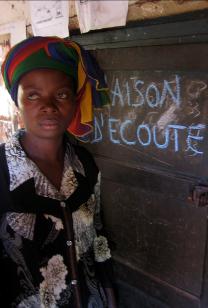

|
The San are the oldest people on the planet.
Observing a sun-baked, wrinkled and wizened San elder, you might believe them to be literally the oldest person on the planet—hands like twisted clubs on the end of twig-like wrists, eyes so deeply buried in leathery wrinkles that all you see is a tiny gleam of amusement, peeping out over a toothless tobacco-stained grin. However, though these individuals are indeed very old, it is their lineage and culture which is oldest of all.
You may be familiar with the film The Gods Must Be Crazy, in which a tribe of Ju/’hoansi hunter gatherers—before “first contact” with modern people—have their lives turned upside down by a Coca-Cola bottle dropped carelessly into their village by a passing air plane. Around here, everyone knows of the film, largely because the “stars” of the film are their uncles, aunts, in-laws, and cousins. They are bemused that their friends got to be movie stars and irritated by how the film misrepresented their people. Though the San are some of the world’s last indigenous people to leave their traditional lifestyle, it has been many decades since a Coke bottle would have inspired any kind of surprise.
I mention The Gods Must be Crazy to illustrate the myth of the primitive Noble Savage that still surrounds the San, as well as other indigenous peoples around the world. Yes, a century ago there were still San living in the bush, hunting and gathering. Now, there is not a single San person who survives from hunting and gathering, and there is not a single San person who would turn down an ice-cold Coke. What remains is the memory of that way of life. For the elders, it is a first-hand memory—some of them grew up with that ancient lifestyle. For others, it is a deeply-rooted yearning. I thought, upon arriving in the dusty outpost of D’Kar, that although people mourned their lost way of life, they would now want the conveniences of modernity. Wrong! Most of the people I ask, when given the rhetorical choice between a nice house in the city and life in the bush, choose the bush. Many elders complain that going to school gets in the way of teaching their children traditional knowledge, and merely fills their heads with irrelevant nonsense in Setswana and English.
Confronted with that point of view, I found myself wondering, “Why did we leave the bush? Why should these kids be forced to go to school?” Of course a thousand answers come to mind, but it’s questions like these which have made my experience in D’Kar so valuable. In a way, it seems that everything here is pared down to its essentials, taken back to first principles. Many people have no houses, yet some of them flatly refuse the efforts of the Komku Trust to build a house for them. A house is a complication they do not feel they need. Again, I question what I’d never questioned before: “Why do we want houses? Do we really need them?”
Rather than experience a gradual change over thousands of years, the San are being asked to transition immediately, from a hunter-gatherer life to modern Botswana. Reasonably, they are asking “why,” and in listening to their questions I find myself re-examining my own life and the entire development of modern civilization. I realize that this sounds ridiculous, but we accept that living in another culture causes us to question our own culture; living with the San brings up those same questions as well as more fundamental ones about all sedentary/agriculture-based cultures.
At times it seems that the two missions of the Kuru Family of Organizations (of which the Komku Trust is a member) contradict each other: (1) Preserve the cultural heritage and way of life of the San, and (2) Bring them into modern Botswanan life as equals. Both of these tasks are difficult, and neither have simple solutions. However, the joy found in an elder teaching a child about traditional medicines, or a community member touching a computer for the first time, make it well worth the effort. It is these joys, and the unique challenges of working with indigenous people, that have kept me here and indeed convinced me to stay beyond my Princeton in Africa fellowship for another year. |
|
by Jenn Ruskey, ‘08-’09 Fellow at Komku Trust in Botswana |
|
Notes from the Field |
|
Jenn poses with a co-worker on a giant cement crocodile outside of the “Crokovango” Croc Farm |
|
Two ladies at a health workshop in Grootlaagte |
|
Kalahari skies |
|
Award-winning documentary film Youssou N’Dour: I Bring What I Love opens in theaters June 12. Directed by Princeton alumna Elizabeth Chai Vasarhelyi, the film is a musical journey about the power of one man’s voice to inspire change. Vasarhelyi followed N’Dour, the highest-selling African artist of all time, for over two years— in his native Senegal and throughout Africa, Europe, and America to tell his story. Click here for more information about the film. |
